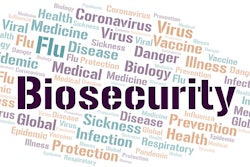The Swine Health Information Center’s Wean-to-Harvest Biosecurity Research Program, funded in collaboration with the Foundation for Food & Agriculture Research (FFAR) and the Pork Checkoff, has recently funded two new projects to advance biosecurity of U.S. swine farms.
The newly funded projects include quantifying trailer contamination rates at the harvest plant interface led by Dr. Cesar Corzo at the University of Minnesota, and assessing viral contamination of mortality disposal structures at wean-to-market farms led by Dr. Igor Paploski at the University of Minnesota. These awards bring the total number of projects to 20 that have been funded by the program for a comprehensive approach to enhancing biosecurity across the wean-to-harvest phases of swine production.
Priorities of the Wean-to-Harvest Biosecurity Research Program focus on site and transportation biosecurity in five targeted areas:
- Personnel biocontainment and bioexclusion
- Mortality management
- Truck wash efficiency
- Alternatives to fixed truck wash
- Packing plant biocontainment
The research program reflects SHIC’s responsiveness to an identified swine health vulnerability and collaborative efforts to leverage producer checkoff funds to safeguard the health of the U.S. swine herd. Proactively enhancing wean-to-harvest biosecurity will help control the next emerging disease in the U.S. pork industry. All proposals submitted undergo a competitive review process by a task force of industry stakeholders with funding recommendations approved by the SHIC Board of Directors, FFAR and Pork Checkoff. Projects are reviewed for their value to pork producers and their ability to provide cost-effective biosecurity solutions on the farm.
Novel tools, technologies and approaches are needed to augment biosecurity practices in the U.S. swine industry. Each of the two newly funded projects investigate unique routes for disease transmission through market transport and mortality management.
First, a project led by Dr. Cesar Corzo at the University of Minnesota was awarded, titled “Quantification of the trailer contamination risk at the harvest plant: An assessment of current trailer positivity rate and associated factors.” Developed in collaboration with the Meat Institute, this project seeks to gather and analyze key data on viral pathogen contamination rates of transport trailers throughout the year at the interface with the harvest facility, including porcine epidemic diarrhea (PED) virus, Senecavirus A (SVA) and porcine reproductive and respiratory syndrome (PRRS) virus. The goal of the research is to understand potential epidemiological factors related to the trailer and unloading process that contribute to increased or decreased contamination risks.
Second, a project led by Dr. Igor Paploski at the University of Minnesota titled “Assessing viral environmental contamination: An investigation of dead animal disposal structures in wean-to-market farms” was awarded. This project seeks to describe biosecurity practices associated with dead animal disposal, assess viral environmental contamination around mortality disposal structures including composting bins and dead boxes, and test an environmental decontamination strategy. The goals of the research are to identify practices associated with viral contamination of mortality structures and develop actionable information for risk mitigation of disease transmission through mortality management.
The Wean-to-Harvest Biosecurity Program continues to accept research proposal submissions which address the five targeted priority areas until funds have been expended. Total project funds available for the program since its inception are US$2.3 million. Real-time results of all projects will be shared as quickly as they become available for producers to implement knowledge gained on the farm.

















